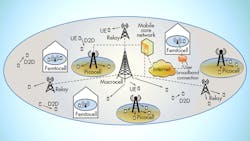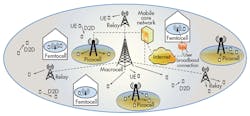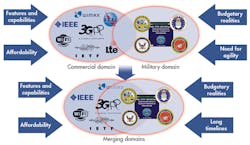This file type includes high resolution graphics and schematics when applicable.
When it comes to transceivers, the RF communications landscape is always changing, ranging from the seemingly constant turmoil in the commercial cellular market to the somewhat more sedate—yet accelerating—rate of change in the military world.
Here are six trends, in no particular order, that are projected to drive changes in transceiver design and development over the next five years.
1. Is the writing on the wall for the power FET? Early predictions of widespread dominance were somewhat premature, but over the next several years, wide-bandgap devices using gallium nitride on silicon (GaN) and silicon carbide (SiC) process technology are expected to gradually replace traditional Si MOSFETs in RF power amplifier applications except for low-end, highly cost-sensitive applications.
Why? GaN and SiC devices operate at higher voltages, temperatures, and frequencies than Si devices, resulting in a reduction in power losses of up to 90%, down to the 1% range. Other competitors, such as super-junction MOSFETs and IGBTs, have technological limits at high voltages (>900 V) and high frequencies respectively.
A comparison of some key metrics is given below. Johnson's Figure of Merit is a measure of suitability of a semiconductor material for high-frequency power transistor applications and requirements. It's a function of two intrinsic device properties—the electron saturation velocity and the electric breakdown field.
Before you rush out and replace all your MOSFETs, though, be aware that both technologies still have problems to be overcome. For example, GaN has low thermal conductivity and defect issues. And SiC has high wafer costs and low electron mobility.
In terms of market penetration, expectations are that for mid- and high-end designs, GaN will dominate in lower-power or lower-voltage (200 V) applications, and SiC at higher voltages and powers. Traditional Si devices will still hold sway in low-end designs. Of course, the predicted GaN-SiC switchover point depends on whether your company manufactures GaN or SiC devices.
2. IoT drives reduced power consumption, feature integration. As we’ve all seen, the Internet of Things (IoT) is ubiquitous these days and it's leading to a slew of products aimed at space-constrained power-sensitive applications such as fitness and medical monitoring. Improvements in battery technology have been slow in coming, and short battery life continues to be one of the main complaints of consumers. To mitigate the problem while still adding the functions customers demand, manufacturers are simultaneously up-integrating features (including transceivers) and reducing power consumption.
For example, Silicon Labs’ EZR32WG230 Wireless MCU family combines a 32-bit ARM Cortex-M4 CPU and sub-GHz Radio into a small, form-factor QFN64 package. The features include up to 256kB of Flash, 32 kB RAM, hardware AES encryption, and multiple analog peripherals such as a 12-bit 1 Msps ADC, a 12-bit 500ksps DAC, 3 op amps, and an on-chip temperature sensor. The RF section is IEEE 802.15.4g compliant, and features a frequency range from 142-1050 MHz, receiver sensitivity of -133 dBm, up to +20dBm max output power, a data rate of up to 1Mbps, and a range of modulation schemes. To minimize power consumption, the EZR32WG230 features a flexible energy management system with run, stop, and shutoff modes; shutoff mode consumes only 40 nA at 3V.
For Bluetooth LE (Low Energy) applications in the sports/fitness and human interface areas, NXP’s QN902X is an ultra-low power system-on-chip (SoC) that combines a 2.4GHz transceiver with a Cortex-M0 microcontroller in QFN48 or QFN32 packages. It includes 64 kB system memory, a four-channel 10-bit ADC, up to 31 general purpose I/O pins, and user-controllable code protection. The RF section features -95 dBm RX sensitivity, TX output power from -24 dBm to 4 dBm, and up to eight simultaneous links in master mode. This device operates down to 2.4V supply voltage and also features multiple power modes—as low as 2µA in deep sleep mode.
3. The connected vehicle considers V2I and V2V communication. Vehicle-to-infrastructure (V2I) and vehicle-to-vehicle (V2V) communications are moving closer to reality after a long gestation period dating back to 1999, when the FCC allocated 75 MHz of spectrum in the 5.9 GHz band (5.850-5.925 GHz) for intelligent transportation systems (ITSs); ETSI followed suit with a 30-MHz allocation in 2008.
Many readers will be familiar with communication from a vehicle to a fixed ground station: GM’s OnStar has been around since 1995, utilizing CDMA mobile phone technology for voice and data communication. But dedicated short-range communication (DSRC) systems for V2V/V2I use differ from conventional mobile communication systems in several ways:
- Users (vehicles) may communicate with each other without relying on a dedicated coordination element (base station or access point);
- Both source and destination stations are mobile and they can move at high vehicular speeds (>120 km/h);
- Communications between users take place at ground level, so that the effects of three-dimensional scattering become significant; and
- The system’s range is small, typically about 400 meters.
These differences call for the design of novel transceivers for V2V DRSC systems that achieve a high spectral efficiency under harsh propagation conditions.
IEEE 802.11p defines enhancements to 802.11 (Wi-Fi standard) to support ITS, using 10-MHz channels. This is half the bandwidth, or double the transmission time for a specific data symbol, than specified in 802.11a. This allows the receiver to better cope with the characteristics of the radio channel in vehicular communications environments—signal echoes reflected from other cars or houses, for example.
Due to the potentially very brief time available for communications, the authentication and data confidentiality mechanisms provided by the IEEE 802.11 cannot be used, so they must be provided by higher network layers. Accordingly, the IEEE 1609 family of standards for Wireless Access in Vehicular Environments (WAVE) standards defines an architecture and a complementary, standardized set of protocols, services, and interfaces that collectively enable secure V2V and vehicle-to-infrastructure V2I wireless communications.
IC manufacturers are already developing transceivers to meet the anticipated need. For example, Austrian manufacturer Kapsch’s 5.9 GHz transceiver MTX-9450 supports both the 802.11p WAVE standard and IEEE 1609.2 security protocols. Key features include: +33dBm EIRP maximum radiated power; 6 x 10 MHz channels (172, 174, 178, 180, 182,184) and 6 x 20 MHz channels (173, 175, 177, 179, 181, 183); 24V or 48V supply voltage; 3DES, AES, and optional ECC encryption; external or built-in directional antenna; and GPS, 10/100 Ethernet, and RS422 interfaces.
Lest you think that all of this is pie-in-the sky, GM CEO Mary Barra announced at the Intelligent Transport System World Congress in Detroit in September that V2V technology would be included in the 2017 Cadillac CTS. The system will be provided by Delphi using application software from Cohda Wireless and NXP’s wireless chipset. And this month, U.S. Transportation Secretary Anthony Foxx announced an accelerated schedule for NHTSA’s proposal to require V2V equipment on new vehicles.
This file type includes high resolution graphics and schematics when applicable.
5G, LTE, and More
This file type includes high resolution graphics and schematics when applicable.
4. 5G on the horizon. At IMS 2015 in Phoenix last month, “5G” was on everyone’s lips. Even though it’s five years away from implementation, some key concepts are emerging that promise to drive changes in transceiver design:
Millimeter-wave communications. Given the full utilization of the spectrum currently allocated for cellular communications (as noted elsewhere in this article) and since 5G single-user peak data rates will be in the 10Gbps range, it’s anticipated that expansion into millimeter-wave frequency bands (e.g., the 28-GHz, 60-GHz, or 71-GHz bands) will be needed, since it allows wider bandwidth transmission than the 20 MHz used for 4G systems. There are hardware problems to be solved, though, including the high power consumption of mixed-signal components such as ADCs and DACs.
Massive MIMO. This is a type of MIMO where the number of BS antennas is much larger than the number of devices. Its implementation involves replacing the expensive, high-performance BS RF amplifier with hundreds or thousands of low-cost amplifiers with much lower power levels. This approach renders the channels to the different devices quasi-orthogonal, giving large gains in spectral efficiency. Studies have shown that a 4 x 4 MIMO array gives 100% improvement in gain for a single user over a 50-MHz bandwidth channel versus a single antenna. An 8192-antenna array serving 1,000 users randomly in a 6km-radius cell gives a 7,000% improvement compared to the 4 x 4 baseline. The downside is increased complexity of the transceiver hardware (number of RF amplifier front ends) and the complexity and energy consumption of the signal processing at both ends.
Heterogeneous networks (HetNets). 5G network proposals (Fig. 1) envision a wide range of communication channels—a combination of femo, pico, and macrocells, and direct device-to-device (D2D) communications including other channels such as Bluetooth and Wi-Fi Direct. It's also likely that Downlink/Uplink Decoupling (DUDe) will be employed to maximize network throughput and reduce power consumption.
5. LTE spectrum wars lead to transceiver design complexity. The LTE (Long Term Evolution) standard provides significantly increased peak data rates, with the potential for 300Mbps downstream and 75 Mbps upstream, reduced latency, scalable bandwidth capacity, and backwards compatibility with existing GSM and UMTS technology.
Following the initial proposal in 2004 by NTT DoCoMo in Japan, implementation plans are proceeding across the globe with South Korea, Japan, and Australia leading the way, followed closely by the United States. The standard is widely supported by current generation smartphones.
Finally! A common international standard. Worldwide roaming is just around the corner, right? Not so fast. Unfortunately, the allocation of radio spectrum for LTE usage varies widely from country to country, even within countries. With the demise of UHF TV and the auctioning off of its spectrum, it was hoped that 700 MHz would become an international roaming standard for LTE. Currently, though, spectrum used for LTE ranges from 700 MHz to 2.6 GHz with 700 MHz coming in at No. 3.
Even in the U.S., the 700 MHz band is divided into a lower band at 698-746 MHz and an upper band at 746-806 MHz. The large nationwide suppliers use slightly different paired blocks, but can afford to have transceivers developed specifically for their phones; this initially led to disputes with regional carriers who claimed that economies of scale meant that they could not offer affordable devices to customers. Over time, many of these smaller providers have been swallowed up by their larger competitors.
These varying LTE bands, plus the need to accommodate differing legacy systems, are driving increased complexity in transceiver design. Current transceivers must support multiband operation, both TDD and FDD technologies, and legacy systems such as GSM, EVDO, CDMA, etc. This in turn leads to increased costs and power consumption.
As various competing 5G proposals are developed, it is expected that this trend will continue.
6. Military communications leverage commercial applications. Certain elements seem to be common to military systems, whether wireless or not: they're designed to meet a rigorous set of performance requirements; they have to operate in harsh environmental conditions; they must include extreme levels of security and resistance against being compromised, including the likelihood that they will fall into the hands of an enemy. To that list the cynic might add that they usually take many years to come to fruition, are often massively over-budget, and trail behind the commercial sector in performance.
Perhaps no longer. The military is increasingly adapting commercial wireless technology for its own use. There are many reasons for this trend, including:
Cost. In an era of budget constraints (and well-publicized stories of $640 toilet seats, $7,600 coffee makers, and federal contractor misconduct), there is heightened awareness in both the military and the government of the need to make better use of taxpayer dollars.
Life cycle. Military operations have changed significantly over the past decade. Instead of facing the massed tank divisions of the Soviet Union, today's soldiers must confront a range of small-scale opponents who adapt and change continually, and who take full advantage of commercial communications capabilities.
Features. With their compressed development cycles, commercial technologies are often far superior to military equipment that was first proposed 10 or 20 years ago.
Recognizing that military equipment has unique security and environmental requirements that cannot be met by purely commercial solutions, military and government communications systems are taking the best commercial devices and embedding them within a secure framework. To help in this effort, the National Security Agency (NSA) established NSA Commercial Solutions for Classified Communications (CSFC) guidelines to enable commercial products to be used in layered solutions protecting classified data. This provides the ability for users to securely communicate based on commercial standards.
For example, the Motorola Solutions Assured Mobile Environment (AME) 2000 Secure Mobile Solution combines a commercial-off-the shelf (COTS) device based on the Android OS with hardware and software to provide end-to-end encrypted voice and data communications through private or public wireless networks to support the missions of federal agencies.
And in another project, investigations are underway to use commercial frequency agile transceivers for multi-GNSS (Global Navigation Satellite System ) military applications while still meeting military anti-jamming and anti-spoofing requirements.
The bright side to the varied list of trends discussed above? Continued employment for transceiver design engineers.
This file type includes high resolution graphics and schematics when applicable.



